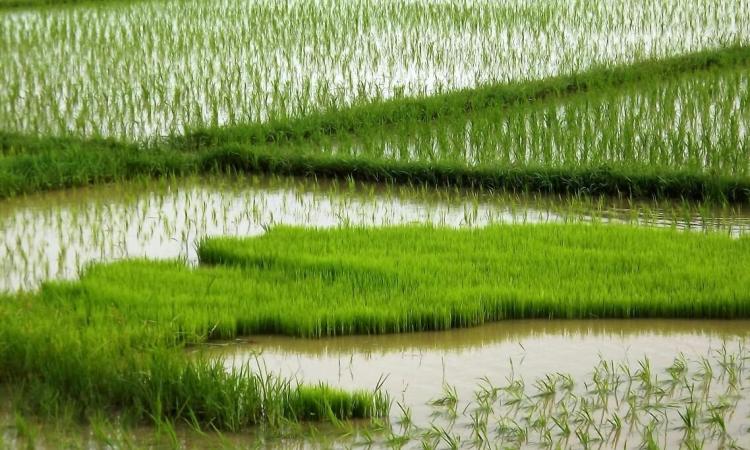
In recent years, cycles of extreme drought and severe flooding have affected the country’s water availability and crop production. The trend can be attributed to climate change. Scientists have been exploring drought and flood tolerant crop varieties to offset stress conditions that significantly constrain rice production. With the development of new drought and flood-tolerant rice varieties, agriculture scientists hope to ease water constraints and ensure food security.
A study titled Do farmers value rice varieties tolerant to droughts and floods? Evidence from a discrete choice experiment in Odisha, India suggests that “new stress-tolerant technologies have the potential to reduce yield variability and help insulate farmers from the risks posed by these hazards”.
The question is whether farmers prefer and adopt drought-tolerant and submergence-tolerant varieties. Behavioral parameters such as risk and loss aversion play a role in farmers' preferences, even when they recognise that the improved seeds have a potential to protect farmers from crop losses.
The study characterised drought tolerance in terms of yield distributions under different moisture stress conditions, and submergence tolerance in terms of number of days of submergence that crops can tolerate.
Droughts have obvious consequences in terms of yield reductions, especially if droughts occur during key stages in the rice growth cycle in which plant development is particularly sensitive to water requirements. Similarly, floods may also limit the area under cultivation. Both of these consequences have potentially severe implications for overall rice production and farm incomes.
A special report by the IPCC on Managing the risks of extreme events and disasters to advance climate change adaptation finds evidence of a general consensus among climate models for an increasing trend in the length of dry spells in much of southern and eastern India (including Odisha) during the 21st century. A future where rice production is increasingly prone to drought and flood-stress is probable for Odisha. Given that average yields in the state are well below the national average, these changes may have significant implications on farmer livelihoods.
Varieties released for cultivation in eastern India that are tolerant to drought (Sahbhagi dhan) and submergence (Swarna-Sub1) have reported potential benefits from adoption. The objective of this study was to estimate farmers' valuations for drought and submergence-tolerance characteristics in rice seeds using a discrete choice experiment methodology for 400 rice-growing farmers in three districts of Odisha.
Farmers willing to pay more for drought and flood tolerant varieties
The results suggest that, on an average, farmers are willing to pay a significant premium for drought-tolerant technologies. While farmers value reductions in yield variability and protection against downside risk, they may not be willing to sacrifice higher expected yields to attain these. Farmers also highly value short duration rice, as well as being able to store grain and use it as a seed in subsequent seasons. Qualitatively, the results are similar for the sub-samples of drought-prone and flood-prone regions. However, the willingness to pay for most attributes is considerably higher in the flood-prone region than in the drought-prone region, which reflects the socio-economic differences in households from the two regions. Households in flood-prone areas, on an average, have higher mean incomes, are more educated, and are more likely to belong to the general caste in the study area.
Farmers value short-duration rice
Another robust result from the study is high valuation for the short-duration rice. By cultivating a short-duration variety, farmers can escape droughts and floods. However, the results suggest that farmers value the short duration variety even beyond its ability to escape abiotic stresses. In addition, farmers cultivating short-duration rice are able to supplement their income by either cultivating a short duration vegetable crop after harvesting their kharif rice or by taking advantage of non-agricultural opportunities after the kharif harvest.
The results from the study are useful for researchers developing these new technologies in determining the traits they should focus on. They are also useful in guiding public and private sector investment in the development and delivery of such technologies.
The results suggest the existence of naturally occurring market segments. In particular, the result that farmers in both drought-prone and flood-prone areas are willing to pay for seed technologies that provide protection against droughts suggests that all farmers—even those not residing in designated drought-prone areas—perceive susceptibility to droughts. This may be a result specific to Odisha, in which many areas have historically endured prolonged dry spells. Furthermore, much of Odisha has little irrigation infrastructure with which to buffer production during these dry spells.
A different story emerges altogether when the study considers potential markets for submergence-tolerant varieties such as Swarna-Sub1. Farmers in drought-prone areas are very clearly not willing to pay for protection from prolonged floods, and so would not be a viable market place for such products. There does appear to be potential demand for submergence tolerant products in flood-prone areas, but the marginal willingness to pay for protection against prolonged submergence is small in comparison with the marginal willingness to pay for other traits, such as shorter duration.
This perhaps suggests that while farmers in flood-prone areas might be aware that floods are a threat to their production, floods of such a prolonged duration are sufficiently rare as to not justify a large valuation. While there is a positive valuation, this is perhaps a cautionary note about the potential success of marketing a product like Swarna-Sub1.
The paper can be read here